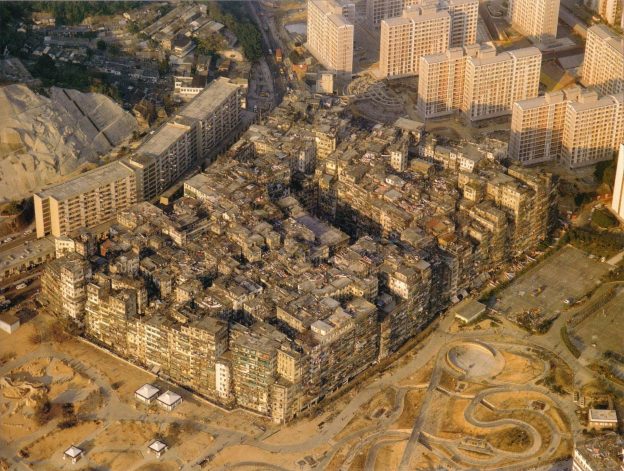The ways in which cities and other living environments are mediated are quite known and researched. If there is a mediated city, surely there exists an unmediated counterpart?
In various contexts, an unmediated city is seen as a city that is not mapped and thus unpredictable. Such an uncharted area is perhaps generally seen as not subject to human intervention, but even abandoned or unlawful constructs could be seen as unmediated ones – given that they have not been mapped and brought into broader knowledge. In many cases throughout the history, the construction of new complexes has either been overlooked by the government due to a political crisis, or the construction has been halted due to financial problems.
Examples of such constructs could include the now-demolished Kowloon Walled City in Hong Kong (inspiration for many dystopian books and films), or Torre de David in Caracas, Venezuela (damaged in 2018 earthquakes). Both of these constructs or complexes could be considered unmediated as they were unmapped, uncharted, unfinished. But they were mediated by their inhabitants, who are told to have formed closely-knit communities in order to overcome the threats from outside the complexes. The inhabitants took matters into their own hands and modified the complex according to their own wishes.
The remnants of Pripyat (Ukraine) could also been seen as unmediated: of human origin, but all objects and belongings have been scattered around the ruins as people fled the vicinity of Chernobyl reactor, and being scattered further by the forces of nature, animals and the occasional scavenger. No one has intentionally arranged the decaying objects – they are where they were left, and no one is looking after them. (Side note: there is also a great documentary about people who still live in the area.) A mediated city is different: trash are picked up, graffitis and tags get removed, broken sidewalks are repaired by workers assigned to tend to them.
Is the internet mediated or unmediated? In the 1960’s Marshall McLuhan theorized the introduction of new forms of communication would form a global village, not only revolutionizing the way people communicate, but also extend its effect into all areas of human life. According to McLuhan, time would cease and and space would vanish entirely, reuniting people with their primordial nature and tribal emotions. McLuhan argued we would enter a period of post-history, as the past and present would become intertwined and be simultaneously present.
Elissavet Georgiadou pointed out in 2002 that the internet was (and still is) populated by the elite. Ultimately, the reasons behind the digital divide are poverty as well as political and cultural control. “The development of the Internet is interrelated to geographical and social inequalities”, Georgiadou wrote.
Has current technology as well as everyday media usage managed to create the global village McLuhan wrote about? Is the internet more mediated now that it was 10 or 20 years ago? How to mediate such a global village, when inhabitants of a city have little to no way of having an effect on their surroundings? What kind of media infrastructures could unmediated areas offer?
(Photo: Kowloon Walled City in 1989. Ian Lambot, Wikipedia)


